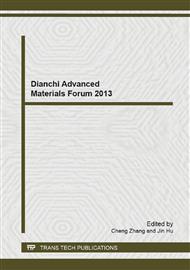[1]
R. Balgobin, B. Garcia, D. Karamanev, et al, Preparation and proton conductivity of composite SiO2/Poly (2-hydroxyethyl methacrylate) gel membranes, Solid State Ionics. 181 (2010) 1403-1407.
DOI: 10.1016/j.ssi.2010.07.025
Google Scholar
[2]
S.K. Dhoke, A.S. Khanna. Study on electrochemical behavior of nano-ZnO modified alkyd-based waterborne coatings, Journal of Applied Polymer Science. 113 (2009) 2232-2237.
DOI: 10.1002/app.30276
Google Scholar
[3]
E. Dzunuzovic, M. Marinovic-Cincovic, J. Vukovic, et al, Thermal properties of PMMA/TiO2 nanocomposites prepared by in-situ bulk polymerization, Polymer Composites. 30 (2009) 737-742.
DOI: 10.1002/pc.20606
Google Scholar
[4]
G.H. Kim, J.S. Lee, C.M. Koo, et al, Preparation and characterization of thermoplastic composite based on poly(vinylidene fluoride) and multiwalled carbon nanotube, Composite Interfaces. 16 (2009) 507-518.
DOI: 10.1163/156855409x450918
Google Scholar
[5]
V. Martelli, N. Toccafondi, G. Ventura, Low-temperature thermal conductivity of Nylon-6/Cu nanoparticles, Physica B-Condensed Matter, 405(20) (2010): 4247-4249.
DOI: 10.1016/j.physb.2010.06.031
Google Scholar
[6]
F. Raga, F. Bonilla-Musoles, E.M. Casañ, el al, Assessment of endometrial volume by three-dimensional ultrasound prior to embryo transfer: clues to endometrial receptivity, Human Reproduction. 14(11) (1999) 2851-2854.
DOI: 10.1093/humrep/14.11.2851
Google Scholar
[7]
M. Fukuda, K. Fukuda, Uterine endometrial cavity movement and cervical mucus, Human Reproductio. 9(6) (1994) 1013-1016.
DOI: 10.1093/oxfordjournals.humrep.a138625
Google Scholar
[8]
S.Z. Cai, X.P. Xia, C.S. Xie, Corrosion behavior of copper/LDPE nanocomposites in simulated uterine solution, Biomaterials. 26 (2005) 2671-6.
DOI: 10.1016/j.biomaterials.2004.08.003
Google Scholar
[9]
T. Xu, H. Lei, S.Z. Cai, et al, The release of cupric ion in simulated uterine: new material nano-Cu/low-density polyethylene used for intrauterine devices, Contraception. 70 (2004) 153-157.
DOI: 10.1016/j.contraception.2004.02.018
Google Scholar
[10]
G. Tsanadis, S.N. Kalantaridou, A. Kaponis, et al. Bacteriological cultures of removed intrauterine devices and pelvic inflammatory disease, Contraception. 65(5) (2002) 339-342.
DOI: 10.1016/s0010-7824(02)00284-6
Google Scholar


